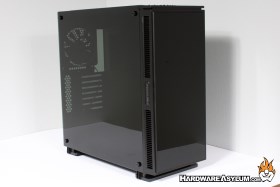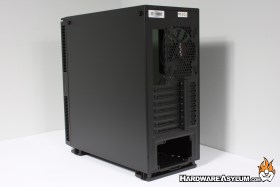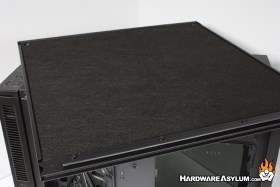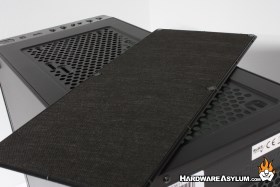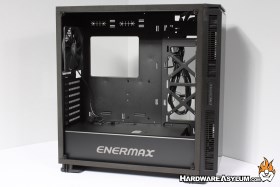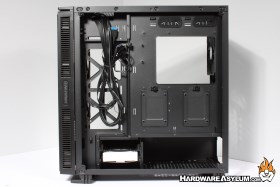Enermax Equilence Silent Case Review
Author: Dennis GarciaCase Layout and Features
From first look the Enermax Equilence is a very clean looking case. You cannot hide the fact that it is basically a box but does feature a thick 4mm tempered glass side panel and an extremely shiny plastic front bezel. In fact the front panel comes with a factory applied paper film like you would find on panels at the hardware store to preserve that shine.
Filpping the case around you’ll see a pretty typical case layout with a 140mm exhaust fan at the top above seven expansion slots and a standard PSU location at the bottom. The reverse side panel attaches similar to tempered glass but is actually a solid metal sheet which is then filled with sound deadening material.
The edges of the panel are squared over to form a channel that not only helps to stiffen the panel but also provides thickness for the material. As you can imagine the panel does have some weight to it and makes a satisfying “thud” when hit with anything.
You can find the same material on the back of the front bezel and under the removable top cover and is also magnetically held in place. The top panel is actually made from plastic however the thick sound panel will go a long way at absorbing any stray sounds emanating from inside the case.
The Enermax Equilence features a full length PSU cover with a large Enermax logo in the middle. Sadly the logo doesn’t light up but is bright enough to stand out even with the side panel installed. As you would expect the PSU cover extends the entire length of the case and doesn’t have any provisions to using thicker fans or certain radiators with more than two fans.
I was rather surprised to see that the interior panels are very flat. No excessive embossing, no stamps and very few extra holes. You'll get a large opening for heatsink access and two grommets at the top of the case for cable routing. The Equilence is using a gap between the motherboard tray and the case to provide cable access.

